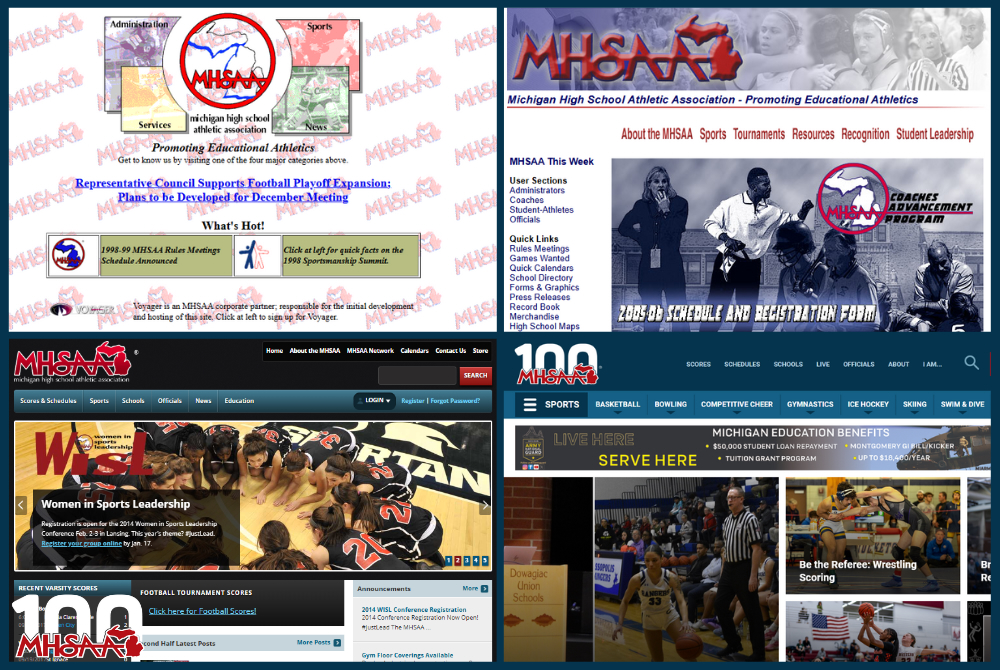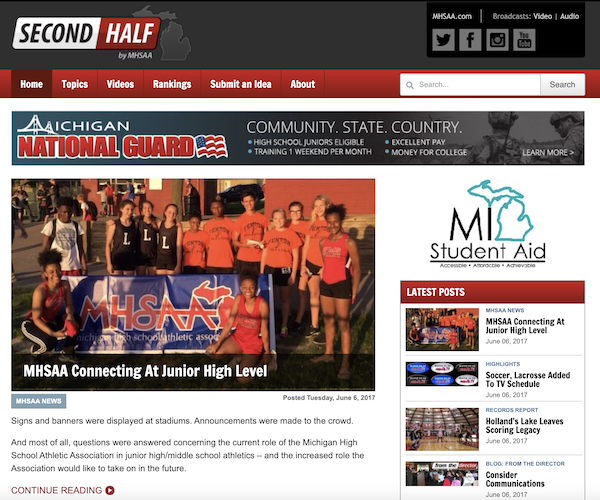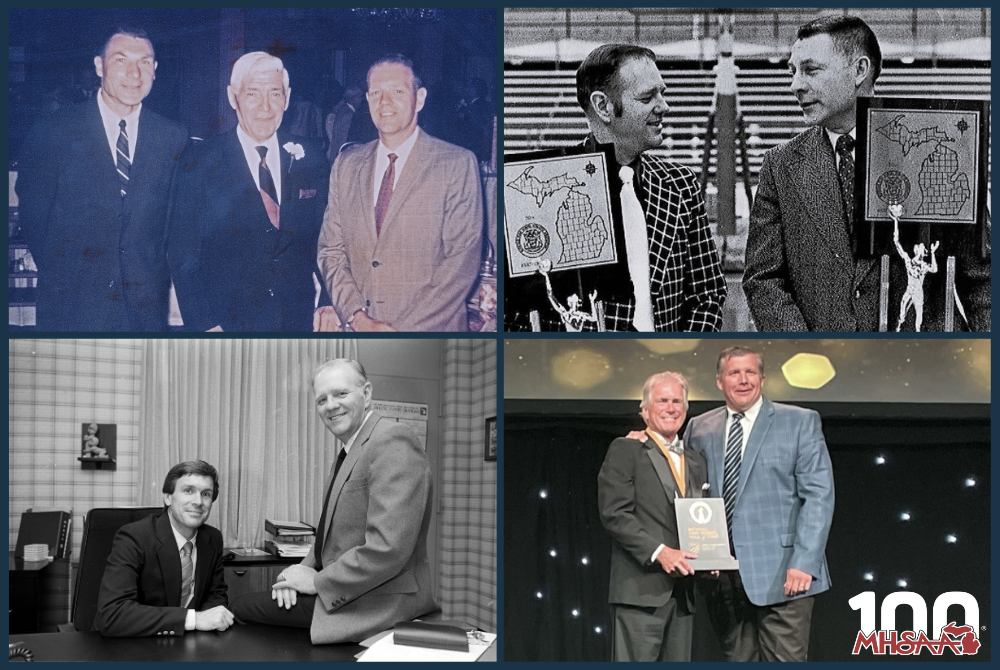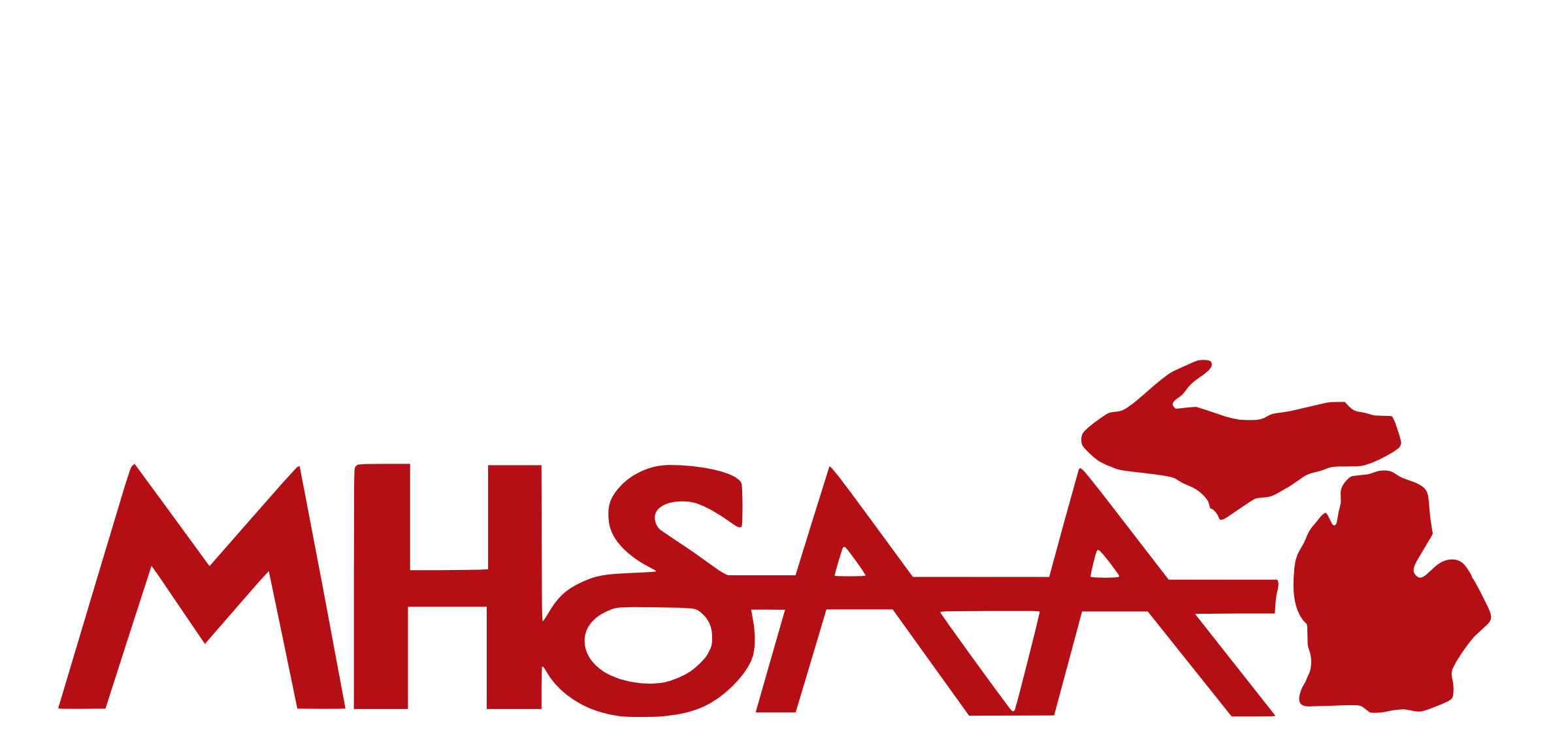
Century of School Sports: MHSAA Blazes Trail Into Cyberspace
By
Geoff Kimmerly
MHSAA.com senior editor
January 9, 2025
When the MHSAA took its first footsteps into cyberspace in 1996 – and then officially launched MHSAA.com on Aug. 15, 1997 – the jump into the internet revolution was to help characterize the MHSAA’s focus on the future, according to a Muskegon Chronicle report quoting then-executive director Jack Roberts.
Predicting how that future would quickly and continuously unfold may have been anyone’s guess. But over the next nearly three decades, MHSAA.com has grown, evolved, added a companion website and then united them into a single valuable landing spot not just for those who work to make our games happen, but the millions who cheer for them as well.
The first rendition of an MHSAA website reached the World Wide Web during Fall 1996 with an American Online (aol.com) URL and included rankings for the MHSAA Football Playoffs. The official version 1.0 of MHSAA.com launched just about a year later, anchored by what would be the website’s priorities for the next 15 years – an area titled “Administration” containing tools primarily for school administrators, a “Services” section highlighting sportsmanship, scholarship and safety; and “The Games” that included sport-by-sport details on rules changes, tournament assignments and historical information.
The MHSAA reported more than 12,000 visitors to its online home during October 1997 – about 400 daily, with the weekly football rankings the largest draw. A little more than a year later, in November 1998, the MHSAA enjoyed its biggest month to date with more than 2,500 visitors daily to climb past 850,000 since the launch of the website. More than 58,000 of those views came during the release of that season’s Football Playoff pairings, and another major draw was the “Games Wanted” page listing teams looking for opponents, which was athletic directors’ biggest ask when surveyed two years earlier on what they wanted most from an MHSAA website.
MHSAA.com already was pushing far ahead of the curve, especially when it came to state school sports associations. But that start was only slightly a sign of things to come. The website has taken on a life that far surpasses any “much has changed, much has stayed the same” scenario.
Truth be told, the goals for the website have not changed in several years – MHSAA.com has provided a place for member school administrators and coaches, and game officials, to do their daily MHSAA-related business. But that mission has been joined by a growing emphasis on telling the story of school sports to the growing number of fans paying us a visit.
 What’s changed is how the MHSAA has delivered on those missions.
What’s changed is how the MHSAA has delivered on those missions.
The website’s design evolved during the final years of the 1990s and first decade of the 2000s, following the fast-moving progression across the internet. Navigation – getting users where they want to go easily – became the buzzword, and adding more and more information to the site meant adding better avenues to find and organize it.
The MHSAA redesign carried out during the 2009-10 school year – the first built by now-longtime partner Gravity Works Design & Development in Lansing – propelled the website in a big way toward what you see today. Navigation menus now remained a static part of every page as users navigated within the site. A large action photo was placed at the top of the front page to bring it to life, as were feeds from the MHSAA’s well-followed social media accounts and a video player highlighting the growing broadcast and video presence.
And then came the largest leap. In late 2011, the MHSAA became one of two state associations nationwide at the time (along with Arizona) to begin creating its own fan-focused editorial content. In January 2012, the MHSAA launched its Second Half website as a home for feature stories, blogs, videos and coverage of MHSAA Finals, produced mostly by longtime media members operating as correspondents from their various regions of the state.
For the 2008-09 school year, MHSAA.com had attracted 19.2 million page views. For 2013-14, the count (including both the main and Second Half sites) totaled 22.5 million. That jumped to 27.2 million for 2018-19. And the most defining design change was still ahead.
While the Second Half’s article content had begun to draw nearly 1 million page views annually – a success considering the state has about 170,000 high school athletes – that content remained separated from an already-robust amount of schedules, scores, results and records data the MHSAA had published on its main site over 25 years, plus all the other postseason promotion and information fans had begun to seek.
So in 2022, the MHSAA made one more big jump to land at the website you’re visiting today.
Paying special attention to not disrupt the work of school people using the site for administrative purposes, the MHSAA closed down Second Half and brought all that content to the front of MHSAA.com – for the first time making the front page of the main website fan-focused. That emphasis on spectator experience continued with new, easier-to-understand navigation, and redesigns of sports pages to better promote MHSAA Tournament events and Michigan Power Ratings (MPR), ticket ordering and record book information fans seek. All of the tools school sports people relied on in the past remain, just flip-flopped with the stories and stats that tell our story to a growing audience.
This new version also is geared differently to better serve an audience that has moved significantly toward viewing on phones. Roughly 70 percent of MHSAA.com page views are coming on mobile devices, and this latest design was built to be responsive and best-serve that visitor preference.
The response to the most recent redesign indeed tells the rest of the story – 38.2 million page views during 2023-24, a 40-percent jump from five years earlier. The largest-drawing single day of the school year was March 1, 2024, with nearly 444,000 views as that year’s Winter tournaments began their final month. Team schedule pages in 2023-24 drew 13 million views, with 2.1 million views of tournament brackets and 1.7 million of the statewide scores page. The site’s editorial content – all of those features, game stories and more – were up to 1.65 million views.
MHSAA.com remains what it’s always been, but now it’s so much more – and no doubt, the best is yet to come.
Previous "Century of School Sports" Spotlights
Dec. 31: State's Storytellers Share Winter Memories - Read
Dec. 17: MHSAA Over Time - Read
Dec. 10: On This Day, December 13, We Will Celebrate - Read
Dec. 3: MHSAA Work Guided by Representative Council - Read
Nov. 26: Finals Provide Future Pros Early Ford Field Glory - Read
Nov. 19: Connection at Heart of Coaches Advancement Program - Read
Nov. 12: Good Sports are Winners Then, Now & Always - Read
Nov. 5: MHSAA's Home Sweet Home - Read
Oct. 29: MHSAA Summits Draw Thousands to Promote Sportsmanship - Read
Oct. 23: Cross Country Finals Among MHSAA's Longest Running - Read
Oct. 15: State's Storytellers Share Fall Memories - Read
Oct. 8: Guided by 4 S's of Educational Athletics - Read
Oct. 1: Michigan Sends 10 to National Hall of Fame - Read
Sept. 25: MHSAA Record Books Filled with 1000s of Achievements - Read
Sept. 18: Why Does the MHSAA Have These Rules? - Read
Sept. 10: Special Medals, Patches to Commemorate Special Year - Read
Sept. 4: Fall to Finish with 50th Football Championships - Read
Aug. 28: Let the Celebration Begin - Read
PHOTOS (Top) Clockwise from top left are images of the front page of MHSAA.com from the years 1998, 2005, this week and 2014. (Middle) This is the front page of the MHSAA's Second Half site from June, 16, 2017.

Century of School Sports: Sharp Leadership Synonymous with MHSAA's Success
By
Geoff Kimmerly
MHSAA.com senior editor
April 2, 2025
Just as an organization often will rise and remain successful when there is consistent leadership, so is consistent leadership often a hallmark of a successful organization.
In celebrating a “Century of School Sports,” it’s no stretch to say the Michigan High School Athletic Association has been successful in its continued promotion and administration of educational athletics thanks in part to consistent excellent leadership in the form of only five fulltime executive directors, and two more directors who also took turns leading the organization through some of its most difficult moments.
Two of the MHSAA’s first four executive directors (who are retired, and therefore eligible for the honor) have been inducted into the National High School Hall of Fame by the National Federation of State High School Associations (NFHS). The first fulltime director – Charles E. Forsythe – became Michigan’s first Hall of Fame selection in 1983. The most recently-retired executive director – Jack Roberts – was selected in 2022.
All five executive directors have had monumental impacts on the direction of school sports in Michigan, not just during their time leading the MHSAA but in their various roles leading up to their service at the top of the organization. The below summaries do not come close to stating their full contributions, but merely some of the highlights for which they are most remembered:
Charles E. Forsythe (1931-42, 1945-68)
The MHSAA’s first fulltime executive director literally wrote the book on leadership of school sports programs – “The Administration of High School Athletics” was first published in 1939 and in five more editions as it became a popular college-level textbook. Previously an accomplished athlete, coach, official and athletic director, Forsythe joined the MHSAA staff in 1929 as an assistant director – and during his long tenure leading the office, school sports became part of the lifeblood of communities large and small all over the state. High school membership increased under his leadership, from 600 to 750 schools, and attendance for the MHSAA Boys Basketball Tournament – the headlining high school event of the day – increased from 126,000 for all rounds in 1930 to more than 775,000 at the time of his retirement. While advances were made in football and boys basketball, and in less-visible sports as well – all driving increased participation – the most notable work under Forsythe’s leadership made sports safer for all participants. Many of the most publicized safety initiatives came in football – including significant equipment requirements – but under his leadership the MHSAA in 1940-41 became just the second state nationally to add an accident benefit plan for participants. Forsythe died unexpectedly in December 1968, only a few months after his retirement. He is the namesake for the MHSAA’s annual lifetime achievement award.
Allen W. Bush (1968-78)
The MHSAA’s second fulltime executive director is the namesake for annual awards presented to contributors to school sports whose accomplishments are often behind the scenes and outside of the attention paid to championships and other high achievements. But Bush’s most-known accomplishments have received some of the greatest attention in MHSAA history, and deservedly so. During his tenure, the MHSAA added its first nine championship tournaments in girls sports, created the Football Playoffs and also began awarding Finals championships in baseball, ice hockey and skiing. Bush joined the MHSAA staff in 1960, serving under Forsythe as an assistant and then associate director.
Vern L. Norris (1978-86)
Norris, who died in 2018 at the age of 89, was known especially for his work with coaches and officials. He had coached at three high schools and was a tremendous official himself, having refereed the 1963 Class A Boys Basketball Final. The MHSAA’s annual Vern L. Norris Award honors an official who has been especially active in mentoring and training officials. Norris joined the MHSAA in 1963 and served under both Forsythe and Bush – the latter as associate director – also playing key roles in the creation of girls sports championships during the 1970s and expansion of those opportunities during the 1980s. He also played a significant role in rules-making nationally, contributing on several NFHS committees, and after leaving the MHSAA served as commissioner of the Great Lakes Intercollegiate Athletic Conference.
John E. “Jack” Roberts (1986-2018)
At the time of Roberts’ retirement, he was the nation’s longest-serving executive director – and with accomplishments in his state and nationally that were arguably unmatched. Under his leadership, the MHSAA grew more than 15 percent to more than 1,500 high schools and junior high/middle schools, and the state’s high school sports participation grew 10 percent and annually ranked higher than states with larger high school-aged populations. The MHSAA again became a national leader in health and safety, setting the pace in concussion care, heat management and CPR certification requirements and policies. The MHSAA also took national leads in coaches education and sportsmanship. Three girls sports and two boys sports were added to the tournament lineup during his tenure, as were 8-player football playoffs and an expansion of the 11-player tournament. Roberts had grown up studying the example of his father John, who served as executive director of the Wisconsin Interscholastic Athletic Association for 29 years, and Jack Roberts also served at the NFHS and Fellowship of Christian Athletes before taking over the MHSAA. Few have given their voice to school sports more prevalently: At the time of his retirement, Roberts had spoken in support of educational athletics in nearly every state and five Canadian providences.
Mark Uyl (2018-)
While his tenure as executive director has not yet reached a decade, Uyl already has steered the MHSAA through one of its most challenging times – the COVID-19 pandemic, which led to the cancelation of the end of the Winter 2019-20 season and all sports the ensuing spring. However, under Uyl’s direction – and while other states remained sidelined – MHSAA schools safely returned to activity during the fall of 2020-21, and despite delays completed their championship events for all three seasons that school year. Also a highly-respected game official on a national scale – and past coach and administrator in Michigan – Uyl joined the MHSAA staff in 2004 and has led the way as participation and officials registrations both have continued to rebound from significant decreases during COVID. His tenure also has seen the addition of an Individual Finals division for girls wrestling and the addition of girls field hockey and boys volleyball set for the 2025-26 school year.
Additional notes of recognition must be paid to two more leaders whose contributions came at some of the most delicate times over this successful century:
Julian W. Smith served as interim executive director while Forsythe served in the U.S. Navy during World War II. Smith – who had served on the MHSAA Representative Council for 10 years – received a three-year leave of absence from his role as principal at Battle Creek Lakeview High School and led the MHSAA through an unpredictable wartime era that included the cancelation of statewide championship events in boys basketball and track & field in 1943, but also their return a year later. He continued the promotion of physical fitness that was emphasized as a mission of school sports especially in preparation for service in the military, and during his time as executive director was named to the National Council of Physical Fitness.
Then there is Alden W. “Tommy” Thompson, perhaps the most influential yet forgotten leader in MHSAA history. Thompson had served on the Board of Control for the MHSAA’s predecessor organization, the Michigan Interscholastic Athletic Association (MIAA) and was then appointed as the first state director of interscholastic athletics, under supervision of the state superintendent and Michigan Department of Public Instruction, about three weeks before the official start of the MHSAA in December 1924.
Charles Forsythe credited Thompson with building the MHSAA “from scratch,” and legendary Lansing State Journal sports editor George Alderton praised Thompson for developing “an eligibility code that was positively fool proof,” classifying schools by enrollment to provide equal opportunities for small and large to win championships, organizing the state basketball tournament to make it financially beneficial to schools which in turn allowed them to spend to develop other sports, and giving a statewide stage to some of those less-visible sports including cross country, tennis and golf. Alderton wrote, “Tommy was the fellow who paved the way, ironed out the humps and gave the machine a push before the motor of popular interest began running.”
Forsythe served as Thompson’s assistant for two years before taking over as state director of athletics in 1931 as Thompson became the state director of physical and health education. However, both would lose their employment with the state’s department of public instruction in 1933 due to budgetary cuts – Thompson, to go on to several more pursuits in athletics, but Forsythe to remain as state director of athletics but now paid fully by the MHSAA, making him officially the association’s first fulltime executive director.
Previous "Century of School Sports" Spotlights
March 25: Athletic Directors Indispensable to Mission of School Sports - Read
March 18: 2025 Finals Begin Next Half-Century of Girls Hoops Championships - Read
March 11: Boys Basketball's Best 1st to Earn MHSAA Finals Titles - Read
March 5: Everything We Do Begins with Participation - Read
Feb. 25: Slogans & Logos Remain Unforgettable Parts of MHSAA History - Read
Feb. 19: MHSAA Tickets Continue to Provide Fan-Friendly Value - Read
Feb. 11: We Recognize Those Who Make Our Games Go - Read
Feb. 4: WISL Conference Continues to Inspire Aspiring Leaders - Read
Jan. 28: Michigan's National Impact Begins at NFHS' Start - Read
Jan. 21: Awards Celebrate Well-Rounded Educational Experience - Read
Jan. 14: Predecessors Laid Foundation for MHSAA's Formation - Read
Jan. 9: MHSAA Blazes Trail Into Cyberspace - Read
Dec. 31: State's Storytellers Share Winter Memories - Read
Dec. 17: MHSAA Over Time - Read
Dec. 10: On This Day, December 13, We Will Celebrate - Read
Dec. 3: MHSAA Work Guided by Representative Council - Read
Nov. 26: Finals Provide Future Pros Early Ford Field Glory - Read
Nov. 19: Connection at Heart of Coaches Advancement Program - Read
Nov. 12: Good Sports are Winners Then, Now & Always - Read
Nov. 5: MHSAA's Home Sweet Home - Read
Oct. 29: MHSAA Summits Draw Thousands to Promote Sportsmanship - Read
Oct. 23: Cross Country Finals Among MHSAA's Longest Running - Read
Oct. 15: State's Storytellers Share Fall Memories - Read
Oct. 8: Guided by 4 S's of Educational Athletics - Read
Oct. 1: Michigan Sends 10 to National Hall of Fame - Read
Sept. 25: MHSAA Record Books Filled with 1000s of Achievements - Read
Sept. 18: Why Does the MHSAA Have These Rules? - Read
Sept. 10: Special Medals, Patches to Commemorate Special Year - Read
Sept. 4: Fall to Finish with 50th Football Championships - Read
Aug. 28: Let the Celebration Begin - Read
PHOTOS Clockwise from top left: (1) Left to right, Al Bush, Charles Forsythe and Vern Norris take a photo together. (2) Norris, left, and Bush hold up Finals trophies. (3) Jack Roberts, left, stands with Mark Uyl during Roberts' induction into the National High School Hall of Fame. (4) Roberts, left, and Norris sit for a photo as Roberts began his tenure after Norris retired. (MHSAA file photos.)

